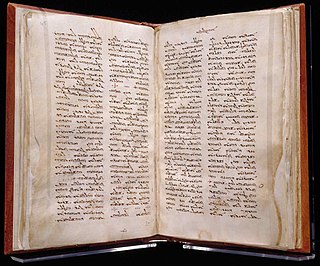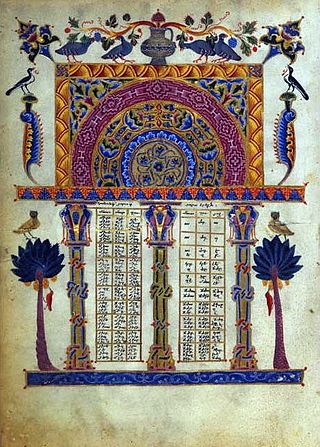Related Research Articles

The Diatessaron is the most prominent early gospel harmony. It was created in the Syriac language by Tatian, an Assyrian early Christian apologist and ascetic. Tatian sought to combine all the textual material he found in the four gospels - Matthew, Mark, Luke, and John - into a single coherent narrative of Jesus's life and death. However, and in contradistinction to most later gospel harmonists, Tatian appears not to have been motivated by any aspiration to validate the four separate canonical gospel accounts; or to demonstrate that, as they stood, they could each be shown as being without inconsistency or error.

Ephrem the Syrian, also known as Saint Ephrem, Saint Ephraim, Ephrem of Edessa or Aprem of Nisibis, was a prominent Christian theologian and writer who is revered as one of the most notable hymnographers of Eastern Christianity. He was born in Nisibis, served as a deacon and later lived in Edessa.

The Septuagint, sometimes referred to as the Greek Old Testament or The Translation of the Seventy, and often abbreviated as LXX, is the earliest extant Greek translation of the Hebrew Bible from the original Hebrew. The full Greek title derives from the story recorded in the Letter of Aristeas to Philocrates that "the laws of the Jews" were translated into the Greek language at the request of Ptolemy II Philadelphus by seventy-two Hebrew translators—six from each of the Twelve Tribes of Israel.
Gregory Bar Hebraeus, known by his Syriac ancestral surname as Barebraya or Barebroyo, in Arabic sources by his kunya Abu'l-Faraj, and his Latinized name Abulpharagius in the Latin West, was a Maphrian of the Syriac Orthodox Church from 1264 to 1286. He was a prominent writer, who created various works in the fields of Christian theology, philosophy, history, linguistics, and poetry. For his contributions to the development of Syriac literature, has been praised as one of the most learned and versatile writers among Syriac Orthodox Christians.

The Peshitta is the standard version of the Bible for churches in the Syriac tradition, including the Maronite Church, the Chaldean Catholic Church, the Syriac Catholic Church, the Syriac Orthodox Church, the Malankara Orthodox Syrian Church, the Malabar Independent Syrian Church, the Syro-Malankara Catholic Church, the Assyrian Church of the East and the Syro-Malabar Church.
Symmachus was a writer who translated the Old Testament into Greek. His translation was included by Origen in his Hexapla and Tetrapla, which compared various versions of the Old Testament side by side with the Septuagint. Some fragments of Symmachus's version that survive, in what remains of the Hexapla, inspire scholars to remark on the purity and idiomatic elegance of Symmachus' Greek. He was admired by Jerome, who used his work in composing the Vulgate.
Jacob of Edessa was Bishop of Edessa and prominent Syriac Christian writer in Classical Syriac language, also known as one of earliest Syriac grammarians. In various works, he treated theological, liturgical, canonical, philosophical and historical subjects, and contributed significantly to scholarly and literary development of Syriac Christianity. He is considered to be one of the most important scholars of the Christian-Aramean tradition.

Hexapla, also called Origenis Hexaplorum, is a critical edition of the Hebrew Bible in six versions, four of them translated into Greek, preserved only in fragments. It was an immense and complex word-for-word comparison of the original Hebrew Scriptures with the Greek Septuagint translation and with other Greek translations. The term especially and generally applies to the edition of the Old Testament compiled by the theologian and scholar Origen sometime before 240.
Aquilaof Sinope was a translator of the Hebrew Bible into Greek, a proselyte, and disciple of Rabbi Akiva.

The West Syriac Rite, also called the Syro-Antiochian Rite and the West Syrian Rite, is an Eastern Christian liturgical rite that employs the Divine Liturgy of Saint James in the West Syriac dialect. It is practised in the Maronite Church, the Syriac Orthodox Church, the Syriac Catholic Church and various Malankara Churches of India. It is one of two main liturgical rites of Syriac Christianity, the other being the East Syriac Rite. It originated in the ancient Patriarchate of Antioch. It has more anaphoras than any other rite.

Theodotion was a Hellenistic Jewish scholar, perhaps working in Ephesus, who in c. A.D. 150 translated the Hebrew Bible into Greek.
Frederick Field (1801–1885) was an English theologian and biblical scholar.

The Bible has been translated to Armenian since the beginning of the fifth century.

Syriac is a dialect of Aramaic. Portions of the Old Testament were written in Aramaic and there are Aramaic phrases in the New Testament. Syriac translations of the New Testament were among the first and date from the 2nd century. The whole Bible was translated by the 5th century. Besides Syriac, there are Bible translations into other Aramaic dialects.
Codex Chisianus 45 (also Codex Chigianus 45; Vatican Library, Chigi R. VII 45; numbered 88 in Rahlfs Septuagint manuscripts, 87 in Field's Hexapla ) is a biblical manuscript variably dated to the 10th century or the early 14th century or early 14th-century biblical manuscript, first edited in 1772.
Translation of the Bible into Malayalam began in 1806. Church historians say Kayamkulam Philipose Ramban, a scholar from Kayamkulam, translated the Bible from Syriac into Malayalam in 1811 to help the faithful get a better understanding of the scripture. The Manjummal translation is the first Catholic version of the Bible in Malayalam. This is the direct translation from Latin. The four Gospels and the Acts of the Apostles were translated by the inmates of the Manjummal Ashram, Fr. Aloysius, Fr. Michael and Fr. Polycarp. The Pancha Granthy came out from Mannanam under the leadership of Nidhirikkal Mani Kathanar in 1924. The Catholic New Testament was published in full in 1940, and has influenced development of the modern language.
Paul, in Syriac Pawlos, was the Syriac Orthodox bishop of Tella and an important translator of Greek works into Syriac.
The Codex Ambrosianus C. 313 Inf. is a Syro-Hexaplar manuscript in parchment form the late eight or early ninth-century.
The Hexaemeron of Jacob of Edessa is Jacob's commentary on the six days of creation of the Genesis creation narrative. Jacob worked on it in the first few years of the eighth century, as it was his final work. Unable to complete it within his own lifetime, the work was finished by his friend George, Bishop of the Arabs. It is an example of a work in the genre of Hexaemeral literature, but should not be confused with a similar earlier work, namely the Hexaemeron by Jacob of Serugh.
References
- ↑ The Scattered Pearls: A History of Syriac Literature and Sciences, by Ighnāṭyūs Afrām I (Patriarch of Antioch). ISBN 9781931956048. p.313.
- ↑ A Short Commentary on the Book of Daniel by A. A. Bevan. ISBN 9781107669949. p.43.
- ↑ Alison G. Salvesen, "Yaʿqub of Edessa" in Gorgias Encyclopedic Dictionary of the Syriac Heritage: Electronic Edition (Gorgias Press, 2011; online ed. Beth Mardutho, 2018), edited by Sebastian P. Brock, Aaron M. Butts, George A. Kiraz and Lucas Van Rompay.
- ↑ "The Origenic signs were scrupulously retained", p. 112 Swete, Henry Barclay. 1914. Introduction to the Old Testament in Greek. Cambridge.
- ↑ 1953. Charles Fritsch. The treatment of the Hexaplaric signs in the Syro-Hexaplar of Proverbs. Journal of Biblical Literature 72.3: 169-181.